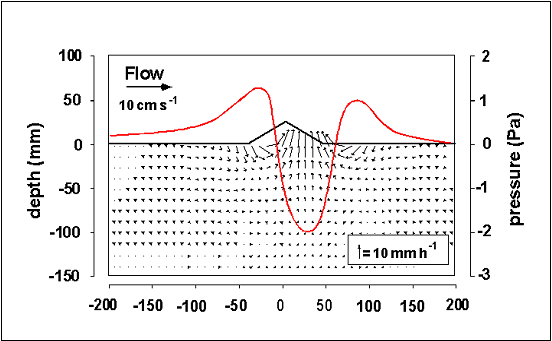|
|
|
Background
COSA project was initiated primarily to gain a detailed understanding of biogeochemical processes taking place in sandy ecosystems. To this end COSA brings together scientists from several disciplines (biology, geochemistry, hydrodynamics) with expertise in a range of sedimentary processes. Here we present a brief background and overview of the processes being studied within the project.
To date, number of detailed studies on sandy sediment biogeochemistry is relatively small; the vast majority of studies of benthic processes have taken place in cohesive, muddy sediments.
A key feature of sandy sediments is their permeability which means that water can flow through the interstices. The deflection of bottom water currents (due to tides, wind, or waves) by bottom topography (ripples, animal mounds, stones etc) creates horizontal pressure gradients at the sediment surface, which leads to advective flow of water through the sediment (Savant et al. 1987, Thibodeaux & Boyle 1987).

A schematic diagram of the pressure variations that develop at current-exposed topographies at the sediment surface (red line) and the resulting pore water flow field (arrows show magnitude and direction) (modified after (Huettel & Rusch 2000)).
The resulting bottom water inflow and pore water release was demonstrated in flume experiments by staining pore waters with rhodamine dye (animation, 12,5 MB).
To date, in-situ measurements of porewater advection rates are rare, but flushing rates of 5-590 L m-2 d-1 have been estimated (Precht & Huettel 2003, 2004) and references therein).
The consequences of advective processes on sedimentary processes may be profound. Sandy sediments, thus, may be unique environments with strong differences to the more widely studied cohesive sediments (Huettel et al. 2003).
One of the most striking features of sands is that these sediments can efficiently trap particles from the overlying water column, thus leading to a high delivery rate of labile organic matter to the sediment (Huettel & Rusch 2000). Advective flushing of the sediment also has important consequences for oxygen dynamics, which has been graphically illustrated by (Precht et al. 2004) (See: http://aslo.org/lo/toc/vol_49/issue_3/0693.pdf) using planar oxygen optodes.
Firstly, it results in a greater oxygen transport into the sediment, possibly affecting the extent and rate of organic matter breakdown in marine sediments (Kristensen et al. 1995, Hulthe et al. 1998, Dauwe et al. 2001).
Secondly it introduces O2 into the sediment on rapidly changing spatial scales. This results in a rapid alternation of oxic and anoxic conditions, which is known to increase sediment metabolic activity (Aller & Aller 1998) and also potentially leading to a tight coupling between obligate aerobic and anaerobic processes such as nitrification and denitrification.
For more information contact Markus Huettel.
The project
While much progress has been achieved in our basic understanding of sandy sediments filtration, there have been no integrated field studies of sandy sediments. COSA utilises state of the art technologies and methods to further our understanding of sandy sediments. Key aspects of the project include:
References
Dauwe B, Middelburg JJ, Herman PMJ (2001) Effect of oxygen on the degradability of organic matter in subtidal and intertidal sediments of the North Sea area. Mar Ecol-Prog Ser 215:13-22
Glud RN, Gundersen JK, R°y H, J°rgensen BB (2003) Seasonal dynamics of benthic O2 uptake in a semienclosed bay: Importance of diffusion and faunal activity. Limnol Oceanogr 48:1265-1276
Herman PMJ, Middelburg JJ, Widdows J, Lucas CH, Heip CHR (2000) Stable isotopes as trophic tracers: combining field sampling and manipulative labelling of food resources for macrobenthos. Mar Ecol-Prog Ser 204:79-92
Huettel M, Gust G (1992) Solute release mechanisms from confined sediment cores in stirred benthic chambers and flume flows. Marine Ecology Progress Series 82:187-197
Huettel M, Roy H, Precht E, Ehrenhauss S (2003) Hydrodynamical impact on biogeochemical processes in aquatic sediments. Hydrobiologia 494:231-236
Huettel M, Rusch A (2000) Transport and degradation of phytoplankton in permeable sediment. Limnol Oceanogr 45:534-549
Hulthe G, Hulth S, Hall POJ (1998) Effect of oxygen on degradation rate of refractory and labile organic matter in continental margin sediments. Geochim Cosmochim Acta 62:1319-1328
Kristensen E, Ahmed SI, Devol AH (1995) Aerobic and anaerobic decomposition of organic matter in marine sediment: Which is fastest? Limnol Oceanogr 40:1430-1437
Middelburg JJ, Barranguet C, Boschker HTS, Herman PMJ, Moens T, Heip CHR (2000) The fate of intertidal microphytobenthos carbon: an in situ 13C-labeling study. Limnol Oceanogr 45:1224-1234
Precht E, Franke U, Polerecky L, Huettel M (2004) Oxygen dynamics in permeable sediments with wave-driven porewater exchange. Limnol Oceanogr 49:693-705
Precht E, Huettel M (2003) Advective pore-water exchange driven by surface gravity waves and its ecological implications. Limnol Oceanogr 48:1674-1684
Precht E, Huettel M (2004) Rapid wave driven porewater exchange in a permeable coastal sediment. J Sea Res 51:93-107
Savant SA, Reible DD, Thibodeaux LJ (1987) Convective transport within stable river sediments. Water Resour Res 23:1763-1768
Soetaert K, Herman PMJ, Middelburg JJ, Heip C, Smith CL, Tett P, Wild-Allen K (2001) Numerical modelling of the shelf break ecosystem: reproducing benthic and pelagic measurements. Deep-Sea Res Part II-Top Stud Oceanogr 48:3141-3177
Thibodeaux LJ, Boyle JD (1987) Bedform-generated convective transport in bottom sediment. Nature 325:341-343
Wenzh÷fer F, Glud RN (2004) Small-scale spatial and temporal variability in coastal benthic O2 dynamics: Effects of faunal activity. Limnol Oceanogr 49:1471-1481
Wijsman JWM, Herman PMJ, Middelburg JJ, Soetaert K (2002) A model for early diagenetic processes in sediments of the continental shelf of the Black Sea. Estuar Coast Shelf Sci 54:403-421
|
|

